Correct dress shirt fit is something most men fail to get right. In fact, if you look around, you'll see most men wearing dress shirts that are 1-2 sizes too large. The result is a shirt that looks awkward and billows at the sides.
It makes you feel uncomfortable, ruins your professional image, and gives off the notion that you don't take good care of yourself.
In this article, we explain exactly how a dress shirt should fit.
The parts to a dress shirt to be considered:
- Dress Shirt Fit: Collar
- Dress Shirt Fit: Shoulder
- Dress Shirt Fit: Torso
- Dress Shirt Fit: Sleeve
- Dress Shirt Fit: Cuff
- Dress Shirt Fit: Sleeve Length
- Dress Shirt Fit: Bottom Hem Length
#1 Dress Shirt Fit: Collar
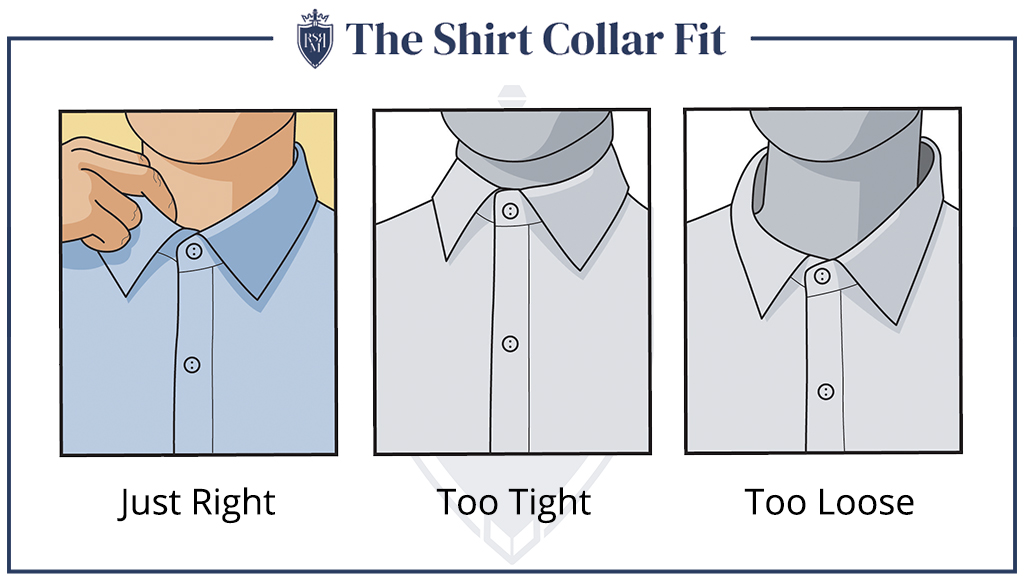
The collar of your dress shirt has one main job – to frame your face. Without a well-fitted collar, you end up with a noticeably unbalanced outfit. That's why you should pay close attention to the collar when you first try something on.
The wrong collar can make a $200 shirt look sloppy, while a great one can make a $20 shirt look amazing.
Too Tight
The collar is close enough to pinch the skin underneath. So you'd feel it right away – and it's pretty uncomfortable. Also, it would be impossible to place a finger between the neck and collar without stretching or tugging.
Too Loose
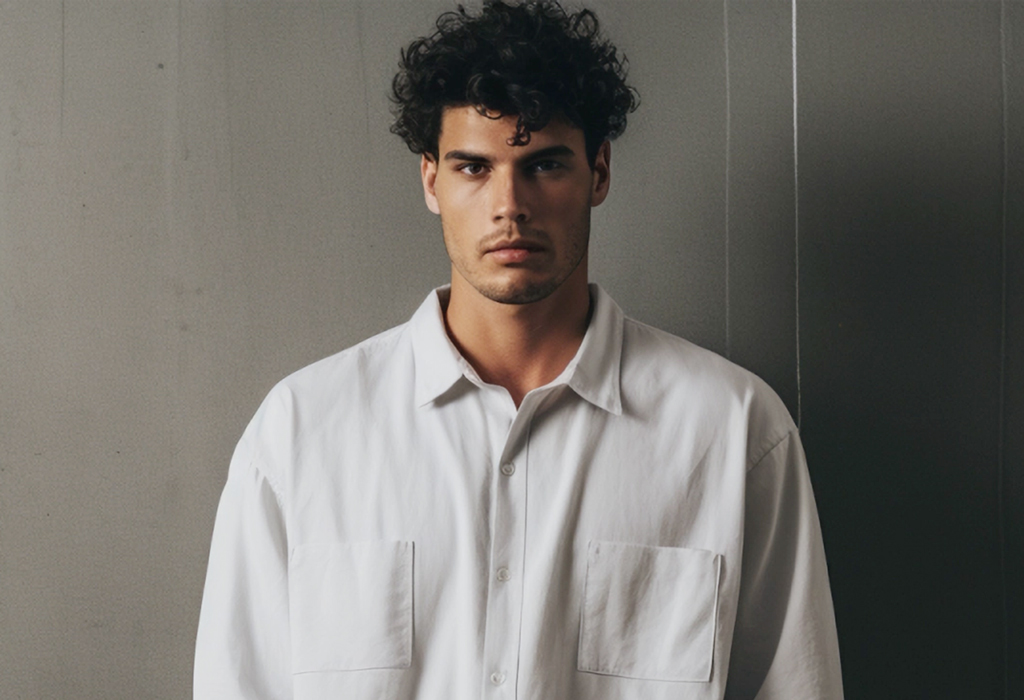
The collar doesn't touch the neck – it rests on the whole area surrounding it, almost like the collar of a coat that you lazily hung up. There's also a gap that's large enough to squeeze in about 4 fingers.
Just Right

The proper fit means that the collar touches the skin around the neck – but doesn't press against it. So you're able to slip 2 fingers comfortably in between your neck and the collar at any point.
#2 Dress Shirt Fit: Shoulder
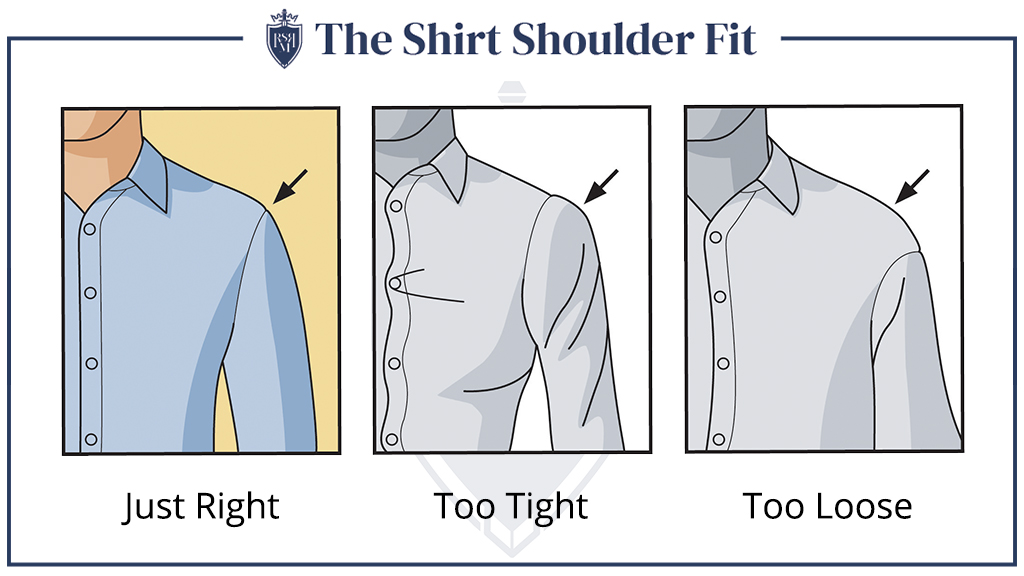
Too Tight
The shoulder points are shifted beyond your shoulders and towards the neck. As a result, part of the sleeves may also end up resting over the shoulders – causing wrinkles.
Too Loose
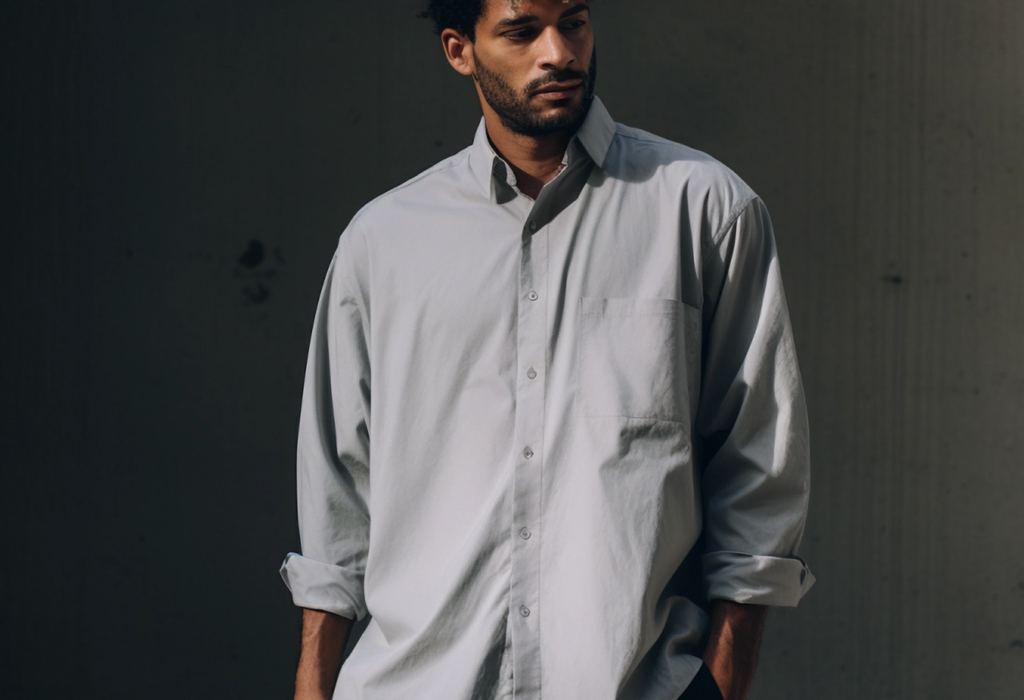
The shoulder points slump off the shoulders and down onto your upper arms. As a result, the shirt is prone to ballooning and making your upper body look broader.
Just Right

This is where the shoulder points sit perfectly at the edge of your shoulders – where the plane of the shoulder meets the plane of the outer arm. The armscye (the hole where the sleeve joins the shirt body) is large enough that it doesn't cause tugging or twisting of the shoulder seam. That allows you to move your arms freely and comfortably.
#3 Dress Shirt Fit: Torso
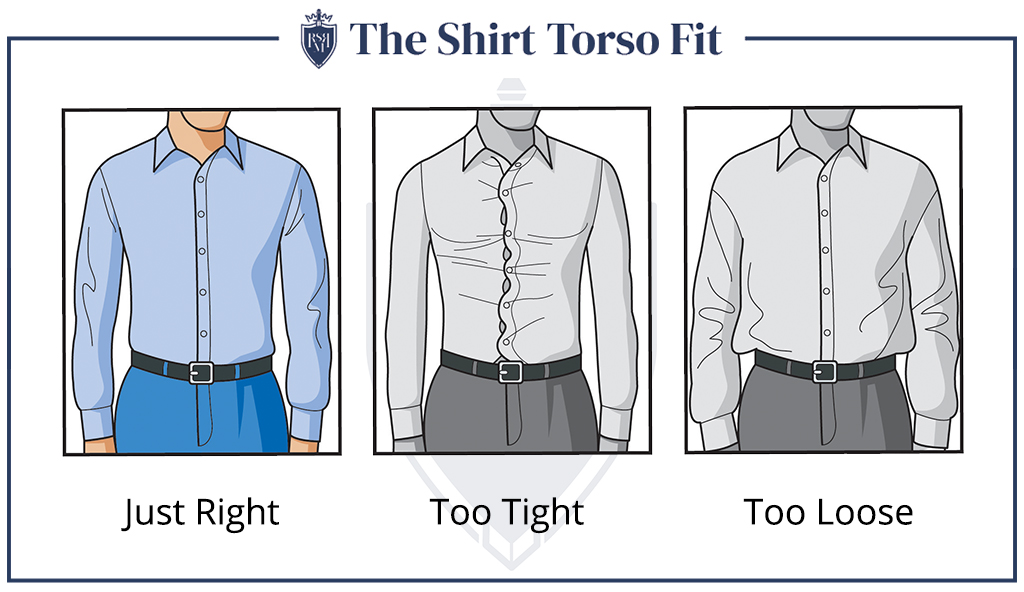
Too Tight
You'll notice that the buttons strain to close, which causes wrinkles to form around the buttonholes. The tightness may also cause some pulling on the sleeves – putting pressure on the shoulder seams.
Too Loose

The excess fabric tends to billow around your waist or chest. This problem causes “muffin-topping” from the waist area. Typically, the solution here is to size down or try another brand with a better fit.
Just Right
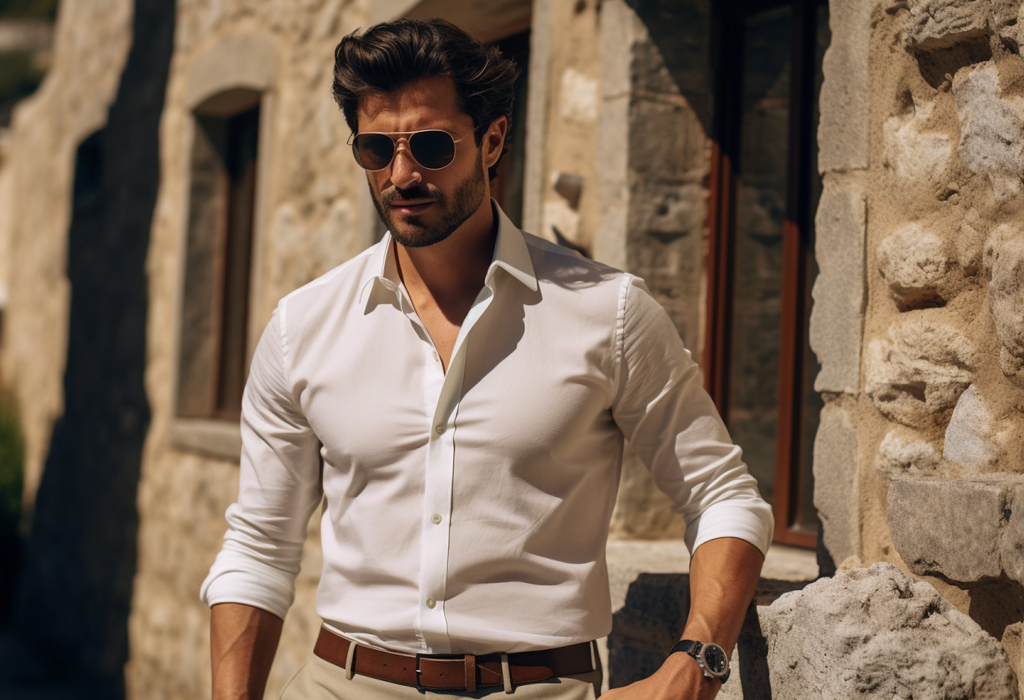
You'll have no problem buttoning up this shirt. The underside of the placket (where the buttons and buttonholes meet) rests lightly against the midpoint of your ribcage. So you can tuck in the shirt without billowing whatsoever.
#4 Dress Shirt Fit: Sleeve
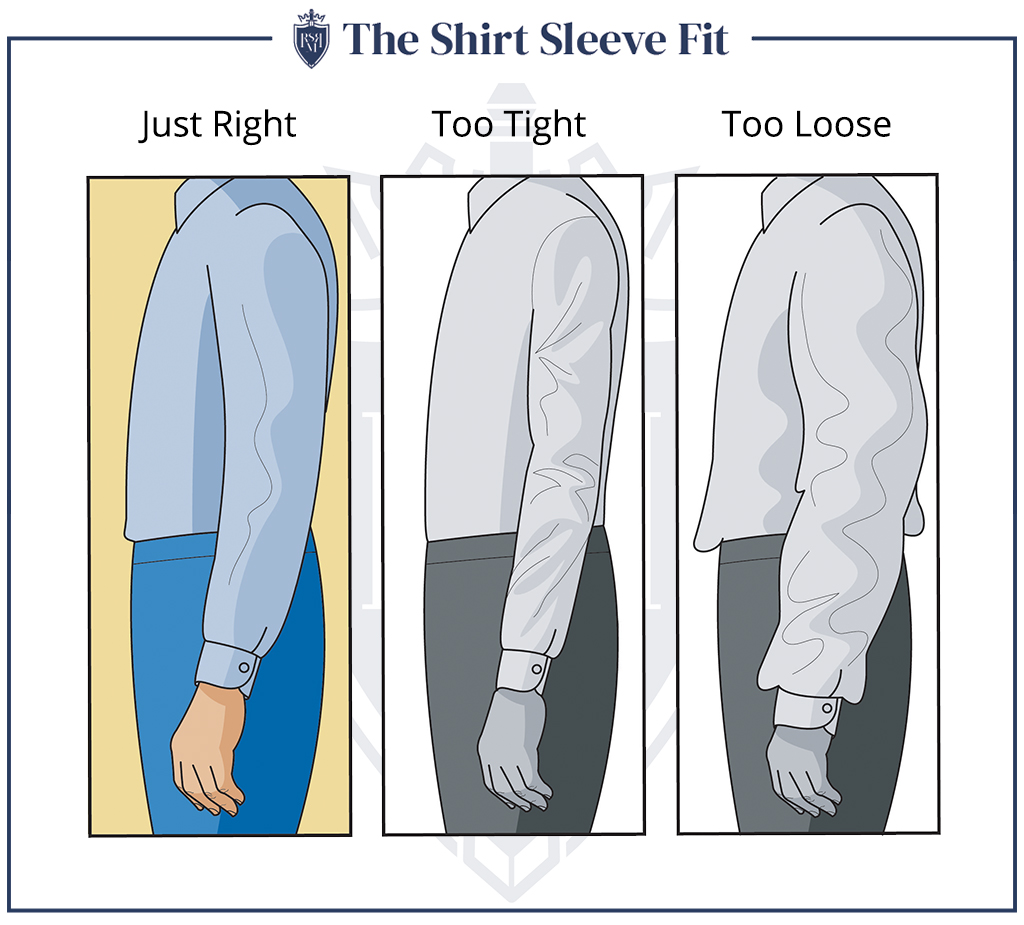
Too Tight
Wearing the shirt with your arms hanging down, you'll get a “pinching” feeling when your elbow or shoulder moves. In addition, the sleeves will limit your movement – and show off too many wrinkles.
Too Loose

The sleeves have so much slack that they naturally create folds of cloth all over – especially around the cuff. In addition, there are inches of excess fabric in the sleeves, so they should either be brought in or sized down.
Just Right

The sleeve should be slightly wider at the upper arm than the cuff – with a smooth, even taper. There's also some looseness (about 1-2 inches of fabric) when the arms hang down straight. This fit gives you enough freedom of movement.
#5 Dress Shirt Fit: Cuff
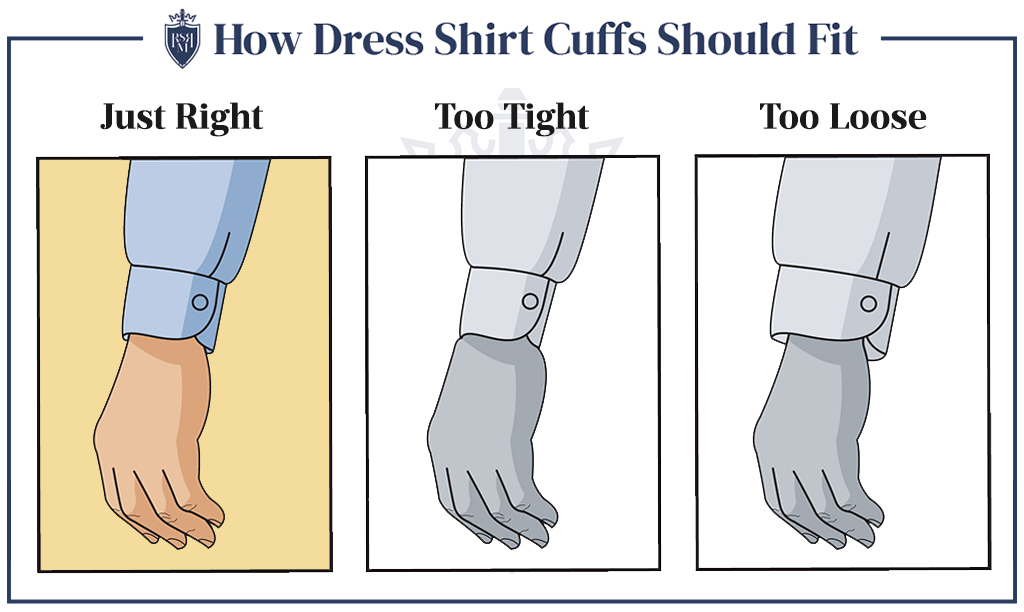
Too Tight
The shirt has sleeves that you can't pull off without unbuttoning the cuffs (or popping a button). The cuffs press against the skin around the wrists – and you feel like they're “strangling” your wrists. In terms of solutions, you may want to move the button or look for a larger size instead.
Too Loose
The cuffs are wide enough to slide loosely over a watch – but still have enough room for some fingers to go in between the cloth and your skin. Folds or wrinkles form in the cuff fabric when your arms rest against a flat surface (like a table). This fit means you'll have to either size down or tighten it up with the cuff button.
Just Right
The cuffs should fit close to the body while still allowing space between the fabric and your wrists. You can quickly put the shirt on or take it off without unbuttoning the cuffs – and hardly any wrinkles form. If you wear a watch often, it's better to size the cuffs on your watch.
#6 Dress Shirt Fit: Sleeve Length
Too Short
The wrist bones are left exposed, or the cuffs disappear underneath the sleeves of your jacket. Unfortunately, neither situation makes the shirt look good – so you'll need to find a different brand with longer sleeves.
Too Long
The sleeves extend to the heel of your hands. This length leads to some fabric bunching up at the point where the cuffs end. When you wear a watch, it's going to be covered by the sleeve every time.
Just Right
The sleeves come all the way down to the large wrist bones (at the base of the pinky/ring fingers). When you're wearing a jacket, about 1/2 inch of shirt cuff is seen beyond the end of the jacket sleeves. The cuff should also touch (and in some postures cover) your watch whenever you wear it.
#7 Dress Shirt Fit: Bottom Hem Length
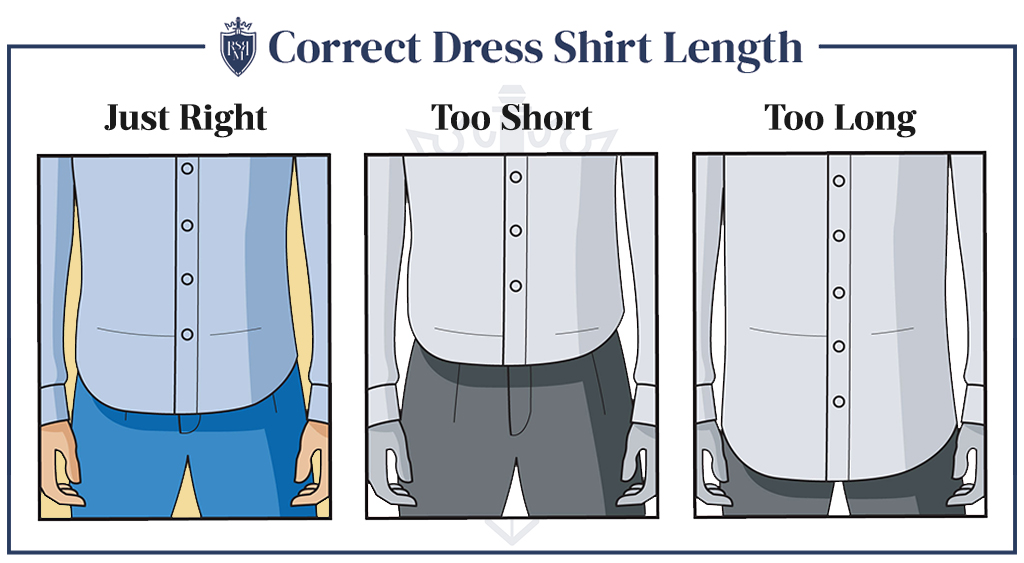
Too Short
When the shirt is untucked, it barely covers your belt line (or the waist of your trousers). Some parts of the hem remain exposed when tucked in and might pop out when your body moves or bends. You'll need a different brand or larger size.
Too Long
The shirttails are long enough to cover the crotch (or extend beyond it). When tucked in, any excess fabric has to be shoved between the legs to prevent bunching up. But compared to other “oversized” things – this one isn't a severe problem. A tailor will be able to shorten this easily.
Just Right
The proper dress shirt length ends a few inches below the beltline – allowing the shirt to stay tucked in when you raise your arms. When untucked, the hem falls just far enough to cover your belt.
In men's style, there are three qualities that affect your appearance: Fit, Fabric, and Function. These three qualities make up the “Style Pyramid.” Click here to discover how to take your style game to the next level!
FAQs: How A Men's Dress Shirt Should Fit
What is the ideal fit for a men's dress shirt?
The ideal fit for a men's dress shirt will sit close to the body without being too tight, allowing freedom of movement. It should be properly tailored at the shoulders, chest, waist, and arms.
How long should the dress shirt be?
The shirt should be long enough to tuck into your pants comfortably, but not so long that it bunches up at the waist when tucked in.
Can a dress shirt be worn untucked?
While a dress shirt can technically be worn untucked, it's generally meant to be tucked in for a more formal and polished look.
Can I move my arms freely in a well-fitted dress shirt?
Yes, a well-fitted dress shirt should allow for full range of motion in your arms without pulling uncomfortably or straining the fabric.
How does a slim fit shirt differ from a regular fit?
Slim fit shirts are generally narrower around the chest and waist, providing a fitted look. Regular fit shirts offer more room and are ideal for men with larger builds.
Are tailored shirts worth it?
Yes, tailored shirts can provide a superior fit and can be more comfortable and flattering than off-the-rack options.
What are 'French cuffs' on a dress shirt?
French cuffs are a style of cuff on a dress shirt where the fabric is folded back and fastened with cufflinks. They are considered more formal than button cuffs.
Should I always have my dress shirt buttoned up to the top?
No, unless you're wearing a tie, it's usually acceptable to leave the top one or two buttons undone for a more casual look.
What's the role of the shirt placket in a dress shirt?
The placket is the double layer of fabric that holds the buttons and buttonholes in a dress shirt. It helps to provide structure and keeps the front of the shirt flat and crisp.
Should the fabric of my dress shirt wrinkle easily?
No, quality dress shirts are often made of fabrics that resist wrinkles. However, all shirts can wrinkle to some degree, especially if they're not properly cared for.
How tight should the shirt cuff be?
The cuff should be snug, but you should be able to slip two fingers into the cuff while it's buttoned.
How do I know if my dress shirt is too big?
If your shirt billows out excessively when tucked in, or if the shoulder seams hang past your actual shoulder, it's likely the shirt is too big.
What's the difference between a dress shirt and a casual shirt?
A: Dress shirts are typically made of finer materials, have stiffer collars, and are designed to be worn with a suit or formal wear. Casual shirts are made with various fabrics and have more relaxed fits.
What are the most common mistakes men make when choosing a dress shirt?
Common mistakes include choosing the wrong collar size (either too tight or too loose), picking a shirt that is too large in the body or the sleeves, and not considering the shirt's fit with the rest of their outfit.
The post How A Men’s Dress Shirt Should Fit appeared first on Real Men Real Style.
0 Commentaires